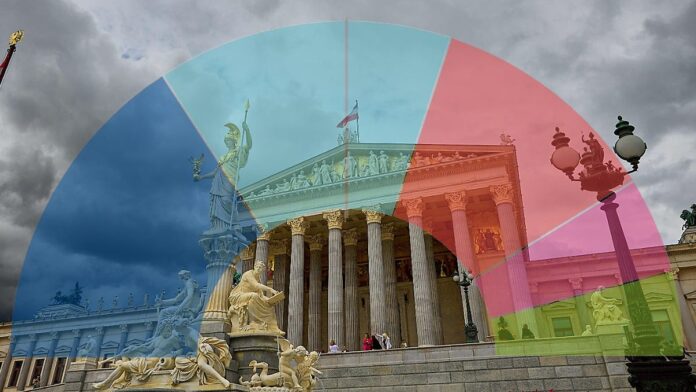Who with whom in Vienna?
The coalition calculator for the Austrian election
September 30, 2024, 11:53 a.m
The morning after the election, Austria is faced with a difficult task of forming a government: FPÖ leader Kickl is the election winner without a majority of his own. The defeated Conservatives could receive the government contract. What coalition options would be possible for ÖVP leader Nehammer?
Austria has voted: In the National Council election on September 29th, the right-wing populist “Freedom Party of Austria” (FPÖ) celebrated a clear election victory. With a result of 29.2 percent of the votes, the FPÖ is the strongest force in the National Council for the first time in the history of the Alpine republic. The conservative “Austrian People’s Party” (ÖVP) with Chancellor Karl Nehammer was only the second strongest party with 26.5 percent.
FPÖ leading candidate Herbert Kickl still has little chance of taking over the reins of government in Austria in the future. Despite strong gains, the right-wing camp is without a sustainable majority in parliament. The task of forming a government should therefore go to the currently incumbent Chancellor and ÖVP boss Nehammer who, however, would have to forge a new coalition with heavy losses in the election. What paths are open? The ntv.de coalition calculator shows an overview of all mathematically possible alliances:
The National Council election creates new balances of power in the Austrian capital Vienna: According to the provisional official final result, the FPÖ receives 58 mandates, the ÖVP 52 and the SPÖ 41. The liberal NEOS platform is the fourth strongest force in parliament with 17 seats, while the Greens will have to make do with 15 mandates in the future. The other parties that took part in the election missed out on entering the state parliament.
It is still unclear which party in Austria will provide the chancellor in the future. The only thing that is certain is that the current turquoise-green government alliance of conservatives and the Greens cannot be continued under Chancellor Nehammer. Nehammer’s ÖVP and the Greens together only reach 67 of the 183 seats. The decisive threshold for a majority is 92 seats.
A coalition of right-wing and conservatives with “People’s Chancellor” Kickl at the head is unlikely. During the election campaign, ÖVP leader Nehammer had expressly ruled out collaboration with FPÖ leader Kickl several times. Collaboration between the right-wing and social democrats would be theoretically possible, but given the sometimes extreme positions of the “freedoms” it is highly unrealistic.
Election winner Kickl made a demonstrative claim to form a government on the evening of the election, but was unable to explain to the public in more detail which party would be considered for his plan. The experienced politician on stage, who has attracted attention in the past for breaking numerous taboos and generally taking extreme positions, remained remarkably vague: The “other parties”, according to Kickl, would have to answer the question “how they feel about democracy” he said, referring to his election victory and Nehammer’s rejection of a government alliance under Kickl’s leadership.
According to the Austrian constitution, the task of forming a government is awarded by the incumbent Federal President after the election. Incumbent Alexander van der Bellen – a former Green Party politician – is formally free to make his decision. The directly elected head of state is not obliged to give preference to the representative of the largest faction in the National Council. This could mean that ÖVP boss Nehammer could come into play as a representative of the second strongest faction.
Based on the available figures, in purely mathematical terms, not only the FPÖ and ÖVP as well as the FPÖ and SPÖ would have a majority in the National Council, but also conservatives and social democrats. However, such a two-party coalition of ÖVP and SPÖ could only rely on a very narrow majority of 93 seats – a single vote above the required threshold.
Together with a third coalition partner, Nehammer’s ÖVP and the SPÖ would have a comfortable basis for forming a new government. A three-party coalition with the Greens or the Austrian Liberals would be possible.
A three-party coalition with the Greens would offer Kickl and the FPÖ an open flank: three parties, all of which lost votes to varying degrees in the election, would probably not have an easy argument to defend themselves against obvious populist attacks. From Nehammer’s point of view, things could look different with the new fourth strongest force: the Liberals already positioned themselves in the election campaign as a force willing to reform and are openly promoting a three-party coalition with the ÖVP and SPÖ. “We are ready,” said NEOS boss Beate Meinl-Reisinger on election evening. “Without us nothing will change.”

